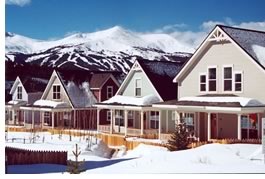
Category: Built Projects
The Wellington Neighborhood in Breckenridge, Colo., provides affordable and market-rate housing on a site that was once home to contaminated mine waste. The project recycles land, creates housing for working families, provides a free transit shuttle to the nearby downtown, and helps the region avoid "mountain sprawl."
 Locals
who work in the historic resort town of Breckenridge were being squeezed
out of the area by median costs of $800,000 for a single-family home.
For many workers, the American Dream was only available across Hoosier
Pass, a 45-minute commute over treacherous mountain roads. Meanwhile,
an 85-acre brownfield site on the town's outskirts allowed zoning for
only four homes.
Locals
who work in the historic resort town of Breckenridge were being squeezed
out of the area by median costs of $800,000 for a single-family home.
For many workers, the American Dream was only available across Hoosier
Pass, a 45-minute commute over treacherous mountain roads. Meanwhile,
an 85-acre brownfield site on the town's outskirts allowed zoning for
only four homes.
Breckenridge has reclaimed 22 acres of this brownfield site to develop the Wellington Neighborhood, a compact community built in the style of traditional neighborhoods with attractive and affordable homes. Fifty eight of 122 approved homes have been constructed. An additional 20 acres is preserved as open space or community parks. The project was planned in two stages: first, the French Gulch Remediation Group (FROG), composed of citizens, property owners, the Colorado Department of Public Health, and EPA officials, worked for several years with the Keystone Center, a non-profit environmental mediation group, to prioritize clean-up actions and funding. Second, Breckenridge officials and residents worked together over four years to plan and design the neighborhood.
 The
Breckenridge Planning Department encouraged Wellington's traditional neighborhood
design through flexible zoning for housing setbacks (closer to the street),
road widths (narrower), and lot sizes (smaller). Housing affordability
is protected through covenants for future generations and purchaser qualification
standards that facilitate transactions and reduce administrative requirements.
The project was funded in part with public sector incentives worth more
than $1 million, as well as a U.S. EPA and Colorado Department of Public
Health and Environment "Prospective Purchaser Agreement" that
partially funded the clean-up and wetland reclamation aspects of the project.
The
Breckenridge Planning Department encouraged Wellington's traditional neighborhood
design through flexible zoning for housing setbacks (closer to the street),
road widths (narrower), and lot sizes (smaller). Housing affordability
is protected through covenants for future generations and purchaser qualification
standards that facilitate transactions and reduce administrative requirements.
The project was funded in part with public sector incentives worth more
than $1 million, as well as a U.S. EPA and Colorado Department of Public
Health and Environment "Prospective Purchaser Agreement" that
partially funded the clean-up and wetland reclamation aspects of the project.
Using smart growth principles, Wellington has increased the supply of affordable housing, cleaned a contaminated site, and created a walkable neighborhood with access to trails and open space. Eighty percent of homes are reserved for purchase by Summit County workers, at about one-third (or less) the cost of the median purchase price in Breckenridge. Wellington's location near downtown Breckenridge places housing near job centers reducing air emissions. New homeowners include the town manager, government employees, shop owners, teachers, and police officers.
Copyright 2002 The American Institute of Architects. All rights reserved.
![]()
|
|
|